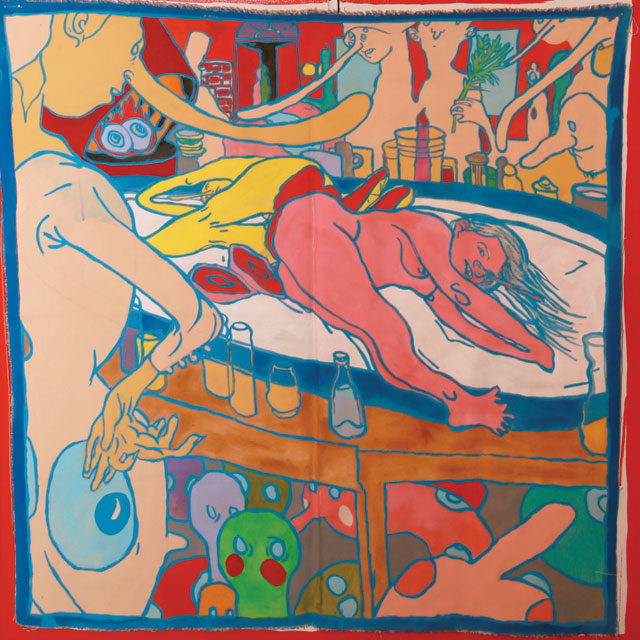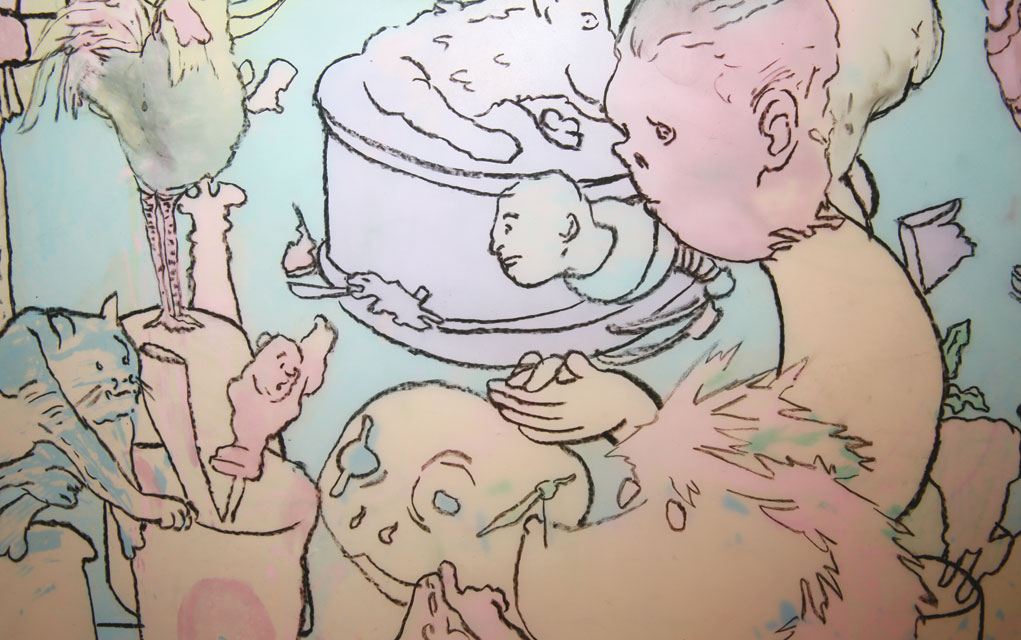
A Dasha Shishkin drawing is by no means straightforward. A picture can show multiple scenes, dozens of characters — some big, some small, some with green skin, some with long, pointy noses. Even her simpler drawings can feature solitary figures with eyes on their bottoms or noses on their nipples.
Now showing at Boulder Museum of Contemporary Art through Sept. 10, Tram Pam Pam exhibits Shishkin’s work. Hailing from Moscow, Shishkin has lived in the U.S. since the early ’90s, working as an artist for the past 15 years. For Tram Pam Pam, Shishkin worked with curators to combine both new and old works.
The large-scale drawings are packed with content. Her pieces depict a world where everything is permissible, and from that she creates meandering narratives.
“They are always concentrating around people and circumstances that are ‘what if?’ They’re not exactly happening next door, but at the same time, there’s this idea that they could potentially be happening next door,” she says. “It’s very interesting to me, these implausible but very possible scenarios.”
While certain situations are clear — a woman giving birth, a character ordering food at a counter — Shishkin never wants to be prescriptive about what’s going on in her work.
“They’re figurative works, so if I say this is a male figure or a female figure, it somehow begins to be that, and I wouldn’t want to do that,” she says.
She doesn’t like to dwell on creating a specific storyline.
“Sometimes they’re not really scenarios, they’re more of happenstances where you have to enter an image somehow, and so you start with an element and that grows legs and begins to develop,” she says. “The ‘what if?’ element comes sometimes when the image is half finished and you suddenly realize the dog is making omelets or something. You allow for that ‘why not?’ situation to take place.”

Throughout the show, there are clear lines of style that emerge. A whimsical surrealism comes across through cooler colors and character distortion. But Shishkin is not keen on labeling her style.
“My present living condition makes me a ‘contemporary artist,’” she says with a laugh. “I don’t feel there’s an aesthetic that I am connected to or that I have devised for myself.”
Her work stems from emotion and intuition.
“Some get colored in and others don’t, simply because some look like they need it and others don’t,” she says.
She likens her process to a scene in Alice In Wonderland. When Alice is lost, she asks the Cheshire Cat where she should go. The Cat asks her where she’d like to go, and when Alice says it doesn’t matter to her, the Cat says then it doesn’t matter which way she goes because she’ll arrive once she gets there.
“It’s the same thing. I don’t know where I want to go with composition or sometimes the whole image,” Shishkin says. “I just know when to stop, because I feel like where I arrived was interesting.”
She stays loose when creating. Some pieces start with an idea, but others start as simple drawings that continue to grow out.
“In some ways, they are very much glorified doodles,” she says, “but in the most respectful way!”
Most of her pieces lack a clear focus. Because of that, Shishkin allows the viewer to choose what piece of the picture stands out most to them, instead of dictating what they see.

“A lot of the pictures have a lot of focal points. There’s not necessarily a single structure or composition with a protagonist or sensical development,” she says. “In the realm of that, I like to have multiple entrances and exits through these multi-figurative pictures, where every character could be the protagonist. I like to let people gravitate to one element or another.”
She encourages the audience to go even deeper and deconstruct each image to just a combination of lines on sheets of paper. Let your eyes go out of focus and look beyond the frame to enter Shishkin’s curious world.
Even though some of her drawings do appear almost alien-like, Shishkin confirms that she is drawing our world.
“These aren’t necessarily fantastical [scenarios]. This is not Battlestar Galactica,” she says with a laugh. “But there are a lot of moments where they’re fantastical people doing strange things.
“Each work, it’s not like it’s nonsensical,” she continues. “But at the same time, some are rhetorical questions and others are more absurdist poems. It takes patience to deal with, but on some other level there’s this aesthetic pleasure that can be derived from the work. There are all these layers that are presented.”
The compositions are open-ended, but each possesses a greater meaning. Her works deal with sexuality, repressed violence, class issues and gender.
“For example, most of the pictures are female, but are they really? What is a male? What is a woman?” she asks. “Not only gender ambiguity but this sort of notion of Shakespearean theater where a man can play a woman. It’s like a Twelfth Night reference, where the clothes can lead you astray.”

Interpreting Shishkin’s work is an individual exercise based on personal perspective. Shishkin says she’s encountered some viewers who think her work is feminist, while others think it’s misogynistic. She’s had certain viewers see influences of Russian art, which Shishkin doesn’t intend but finds interesting.
“Just like beauty is in the eye of the beholder, you can look at something and, depending on your own rotten personality, you’ll interpret it as such — whether you find it profane or funny,” she says. “Basically, whatever you imprint on the situation, it’s about you more than what’s in front of you.”
Blending the heavy social issues with Shishkin’s cartoony aesthetic creates an eerie sensibility. There’s an underlying darkness in the work that leaves the viewer unstable, aware that something isn’t right.
“When you don’t know what it is, it’s sort of the pebble in your shoe,” she says. “You stop, you shake the pebble, and you continue on walking, but it’s still there.
“Why wouldn’t you want to live with this picture in your house? Is it the color? Is it the [subject matter]? Or is it this notion of discomfort?” she asks. “But because this is an aesthetic environment, being in a museum, it’s there to provoke a thought.”
The distortion in Shishkin’s work is another way she abstracts reality to question it. She says she’s drawn to the exaggerated body because it can provide more insight than more realistic forms.

“The moment the body has potential to be rendered, it becomes a portrait and not a caricature,” Shishkin says. “And I think caricature can be very useful, especially to ask a question that’s more ambiguous or even more poignant.”
One way Shishkin achieves this is by her use of eyes. Some figures have multiple eyes covering their bodies, others lie on blankets made of eyes.
“That’s very much this idea of you can’t look anywhere because everything looks at you,” she says. “Nobody can look at your back because your back has eyes. It’s this moment of mutual shame: You’re embarrassed to look up, but everyone’s also embarrassed to look at you as well because everything is looking back at them.”
She got the inspiration from a story she heard as a child about the Angel of Death, who is covered in eyes. When a person knows they’re going to die, the angel gives the person an extra eye, which provides a heightened sense of awareness.
“For a while there I was obsessed with that idea, and I think it started from that theological and scary place. Then it just became funny. Then it went into that territory of being so aware of your body, the self-consciousness of oneself. Not only your face, but your elbows are hideous too,” she says.
As with her work and her process, Shishkin is more concerned with the journey than the destination.
“They were visually stimulating for me, and there was this curiousness of how many eyes can I fit if a person is looking this way, or if they’re laying down,” she says. “Can you see this eye? Can you see those eyes?”
The final product is an image loaded with endless potential interpretations; every time you look at it, it can be something else.
“The possibility that an image can have multiple interpretations is always the goal to some extent, and especially within one individual as well,” she says. “If an image stays with a person for several instances, it’s like a book that you read again and again.”
She likes to think of her work as full of life, a cornucopia of offerings to the audience.
“I think of myself as a benevolent creator,” she says. “I always have this notion of like, ‘OK kids, go!’”














